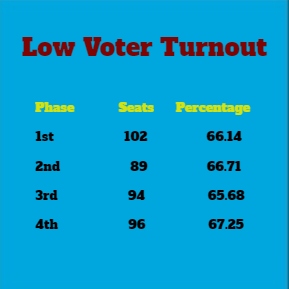

By Linus Garg
First publised on 2024-05-14 07:31:30
After the 4th
phase of voting in the 2024 general elections on Monday 13th May,
concerns over low voter turnout have started causing jitters across the
political spectrum. Voting has been completed for 381 Lok Sabha seats till now.
The turnout was 66.14% (102 seats) in phase 1, 66.71% (89 seats) in phase 2,
65.68% (94 seats) in phase 3 and 67.25% (96 seats) in phase 4. All these phases
showed lower turnout than in 2019. But the major cause may not have been voter
apathy as the heat wave sweeping India was also a big factor in people choosing
not to vote.
Historically,
the incumbent is generally on the back foot when there is low voter turnout.
But this is tempered by the fact that within the low turnout, it depends on who
managed to mobilize loyal voter base to visit the booths and cast their votes.
If the BJP has managed to mobilize its voter base then it need not worry. But
if its voters have stayed away and those of the opposition have voted in large
numbers, then it has a problem at hand. The talk of 400-paar have all but
vanished and the BJP is scrambling to mobilize voters in the remaining phases.
In UP and
Bihar, the two states that together send 120 MPs to the Lok Sabha and where the
BJP, is hoping to beat its 2019 tally, the voter turnout has not even touched
60%, but that is par for the course as these two states have never shown a high
voter turnout due to many reasons, not the least being the absence of many voters
who migrate to other states for work and do not return to vote. Hence, if the
BJP is successful in increasing its tally in UP and Bihar, it might yet return
with a two-thirds majority as it is hoping.
In the last
opinion poll published before the elections in April by ABP News-CVoter, it was
predicted that the NDA will get 46.6% vote share and 373 seats while the INDI
alliance will get 39.8% vote share and 115 seats with 13.6% votes and 15 seats
going to others. This prediction depends on which camp has mobilized its voter
base better. With both camps exuding confidence (mainly for public
consumption), it remains to be seen what, first the exit polls on June 1, and
then the actual results on June 4 have in store for them.











